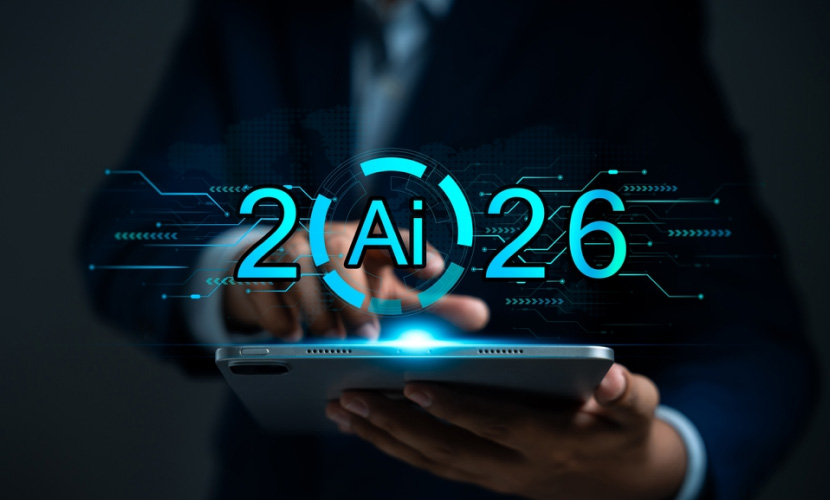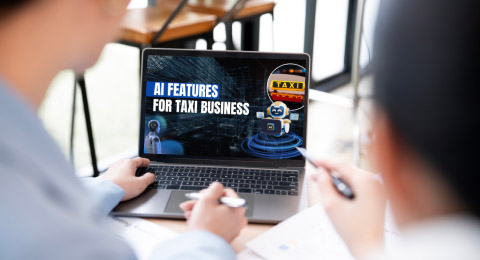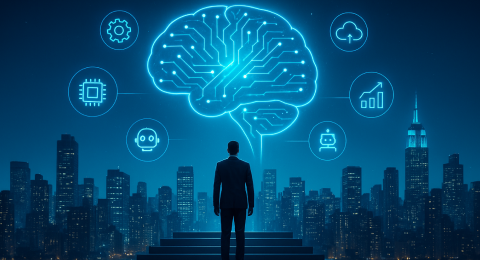
Between 2020 and 2025, artificial intelligence evolved from a basic task doer into a clever system that can learn on its own. That shift equally influenced the way people do jobs, buy things, or choose what to do. Over this period, companies also started using AI to do business smartly. Apps such as ChatGPT and Gemini slipped quietly into daily routines.
- The Evolution and Core Drivers Behind AI Trends in 2026
- Top AI Trends in 2026 for Business – Emerging Opportunities for Entrepreneurs
- AI Prediction in 2026 – What Experts and Data Indicate
- The Rise of Ethical, Transparent, and Responsible AI
- AI Integration Challenges and How Businesses Can Overcome Them
- Preparing Your Business for the Future of AI (2026-2030 Roadmap)
- Investment and Funding Landscape Shaping AI Trends in 2026
- Conclusion
- FAQs
By 2026, AI trends will take this progress even further. We’re going to interact with smart machines that learn, react, and grow almost like people do. Progressive businesses that can take advantage of those dynamic AI features early will stay ahead of the competition.
This blog is going to dive deep into the future of artificial intelligence. You will get a list of the top AI trends in 2026. Understand how upcoming AI upgrades are going to affect business trends, ethical practices, and challenges in adoption as well.
The Evolution and Core Drivers Behind AI Trends in 2026
Thanks to a series of fortunate events, AI grew from a basic rule-based model into a machine learning model with independent reasoning capabilities. As we move into 2026, AI is going to undergo a deep transformation in self-intelligence due to the following key factors.
From Machine Learning to Self-training
During its early phase, AI was dependent on human training. However, AI models are self-reliant. They train themselves on old data without constant human intervention. Instead of merely guessing what comes next, they help agents handle tough calls by providing real-time data and de-escalation guidance.
This self-reliant learning is expected to push AI towards:
- Continuous improvement without the need for manual retraining
- Faster contextual choices by learning from real-time environments
- Fast understanding of user behaviors leading to hyper-personalized experiences for customers
Businesses that can quickly leverage this self-sustaining capability will work smoothly with the next generation of AI systems.
The role of Cloud, Data, and Compute Power
Three major driving forces of AI are advanced cloud computing, big data, and GPU performance. With the help of the trio, AI will shape the future.
For instance, nowadays, you can use cloud platforms to train and deploy AI models without expensive hardware setups. It doesn’t matter how small or big your company is.
Meanwhile, specialized AI chips and quantum computing are further pushing performance boundaries. With new processors, AI can now train deeper neural networks at a fraction of the cost.
The explosion of global data also feeds this growth. With every digital interaction, AI learns and adapts. That said, if you can feed AI with clean and reliable data, it can help you with a higher level of decision-making by 2026.
Government and Corporate Investments Fueling AI Acceleration
A surge in funding plus favorable government rules are speeding up AI advances. Governments are drawing up ethical guidelines for responsible innovations. Take the upcoming EU AI Act, for example. It promotes transparency but also protects user rights. Under such conducive environments, partnerships between big companies, small innovators, and academia are driving progress across healthcare, finance, and sustainability.
Top AI Trends in 2026 for Business – Emerging Opportunities for Entrepreneurs
The AI prediction suggests a turning point where AI models will be capable of reasoning, choosing, and reacting, almost on their own. This level of autonomy will open the door to new AI business ideas, and entrepreneurs will get tons of benefits. With that said, let’s take a look at some top AI trends shaping this transformation.
Agentic AI
Agentic AI can think, plan, and act on its own. It sets goals, makes decisions, and completes tasks without much human help. It behaves like a smart teammate rather than just a tool. Businesses use it in customer service to handle requests, in supply chains to manage inventory, and in finance to track fraud and compliance. That said, Agentic AI will be among the top AI trends.
Rise of AI-as-a-Service (AIaaS)
AI-as-a-service won’t just rely on ready-made APIs anymore. Instead, new players will roll out tailored AI tools. For example, we might see AI built around regional compliance laws or healthcare AI focused on secure data handling from the start.
As a result, entrepreneurs can launch micro-AI startups targeting specific industries instead of broad markets. It will help them build scalable products without reinventing infrastructure.
Physical AI
Physical AI will remain one of the top AI trends for intelligent automation. It connects smart machines with the real world. It uses sensors, cameras, and robotics to see, decide, and act. It powers warehouse robots, delivery drones, and surgical tools. It improves safety, accuracy, and speed in daily operations. Industries like logistics, healthcare, and transportation will benefit the most.
AI-driven Decision-Making and Automation
Businesses are very likely to automate their decision-making with AI. Instead of merely offering choices, AI will do trial runs in simulation mode first. For example, a logistics AI can test thousands of routing scenarios in a flash before execution. Similarly, a retail store can use AI to dynamically adjust pricing as per the market demand.
Human-AI Collaboration Models
The future is about smart teamwork between people and machines. Organizations with a hybrid work culture will use AI copilots to understand how each person works. Rather than just handing out standard suggestions, AI systems will adjust on the fly.
For example, there will be more focus on behavior-aware integration, where AI learns how teams think and augments creativity rather than replacing it.
Sovereign AI
As privacy rules grow tighter, Sovereign AI will stand out among all the AI trends. Sovereign AI gives countries and companies full control over their data and AI systems. It helps keep information private and safe. It ensures compliance with local laws. It lowers risks linked to global data sharing. Businesses that handle sensitive or regional data will adopt it quickly.
AI Prediction in 2026 – What Experts and Data Indicate
The AI prediction for 2026 shows progressive shifts across industries and communities worldwide. Experts believe that instead of just helping out, AI will lead how choices are made and new ideas are discovered. Let’s look at some insights from experts.
Data-driven Forecasts from Leading Analysts
- According to Gartner, by 2026, over 80% of companies will have tried generative-AI APIs or rolled out apps powered by generative AI. That is way up from fewer than 5% back in 2023.
- Meanwhile, as per the PwC AI analysis report, AI might add close to $15.7 trillion to worldwide markets by 2030, with big shifts likely around 2026.
- Forrester Research has stated that the talk around AI is moving toward hands-on tasks by 2026. So, instead of settling for flashy promises, businesses will expect actual results instead.
- As per Deloitte, Agentic AI will be the new norm in the industry. Agentic AI systems can independently set workflows with minimal human intervention. Therefore, they are about to influence businesses with more “out-of-the-box” solutions available.
Industry-specific AI Predictions
Every sector is gearing up for changes powered by artificial intelligence. Here are some predictions.
- In healthcare, clinical trials could speed up with AI-powered diagnosis.
- Similarly, retail is slowly moving into highly customized interactions instead of one-size-fits-all approaches.
- Factories are going to rely more on equipment that predicts failures with automated systems performing routine maintenance alongside.
- Schools might start using AI tools that adjust lessons based on how each learner progresses.
Societal and Ethical Predictions about AI Use
When AI goes mainstream, speculations over job insecurities, algorithmic bias, or digital rights will grow stronger. So, governments are expected to boost ethical AI governance and global cooperation. According to McKinsey & Company, responsible AI policies and value-realization practices will remain the major concerns for enterprises.
Want to Leverage the Power of AI in Your Business? Reach Out to Us with Your Requirements.
The Rise of Ethical, Transparent, and Responsible AI
Responsible AI is gaining strong attention nowadays among all other AI trends. As AI becomes part of everyday business, responsible AI is a moral choice as well as a business necessity. Let’s see how important it is for organizations to prioritize ethics, transparency, and accountability in using AI to stand out from competitors.
Why Responsible AI is a Competitive Advantage
Ethical AI helps build trust, and that trust drives adoption. When users know how algorithms make decisions, they’re more likely to engage with them.
Businesses practicing ethical AI will experience sustainable growth due to the following benefits:
- Ethical branding followed by brand reputation through transparent use of AI
- Increased user trust due to fair and privacy-conscious use of AI
- Easy legal compliance with global laws like the EU AI Act (2026)
Building Explainable and Auditable AI Models
To make AI trustworthy, it must be explainable. Businesses are now investing in tools that reveal how an AI system makes a decision. These tools help detect bias, improve fairness, and make audits easier.
Some important tools are:
- LIME (Local Interpretable Model-Agnostic Explanations) - explains individual predictions.
- SHAP (SHapley Additive exPlanations) - shows which features most influence a model’s outcome.
- OpenAI Evals - helps test and measure model performance transparently.
A fintech startup can use SHAP to understand why its credit scoring model rejected certain applications. The insights are going to help the startup adjust the model, reduce bias, and improve approval accuracy. Moreover, it can remain compliant with new transparency laws.
AI Integration Challenges and How Businesses Can Overcome Them
AI predictions suggest faster adoption but also growing pains. While artificial intelligence thrives on quick results and fresh ideas, plugging it into current setups doesn’t automatically go smoothly. Coming times could bring hurdles like legacy issues or not enough experts who know what they’re doing. This is how to get past those issues.
Top Technical Barriers in AI Implementation
Industries relying on AI may face two major technical challenges.
Legacy Infrastructure
Many businesses stick with outdated tech that doesn’t link well with today’s AI tools. Moving to cloud setups helps handle tasks automatically while managing huge amounts of information smoothly. However, for companies that want to modernize step by step, integrating AI into legacy systems offers a balanced path. Alternatively, you can also choose hybrid models, as they allow you to modernize without shutting down existing systems.
Data Integration
AI models need clean, consistent, and connected data. But most organizations have data scattered across departments. This challenge can be addressed by opting for data lakes or integration platforms that bring all information together in one place.
Talent and Skill Shortage in AI Fields
The global shortage of AI experts continues in 2026. To fill the gap, companies are investing in upskilling programs and AI bootcamps.
How to overcome this challenge?
- Launch internal AI academies to train employees in prompt engineering and data ethics.
- Partner with universities and online learning platforms to expand the talent pipeline.
Overcoming Adoption Hesitation
During the early phase of AI implementation, startups may find it hard to convince stakeholders to invest in AI.
If you see yourself in that position in the near future:
- Start small with measurable use cases to build up ROI records for clients.
- Keep a record of metrics like cost savings, faster decision-making, and improved customer satisfaction before and after using AI.
Preparing Your Business for the Future of AI (2026-2030 Roadmap)
The AI prediction for 2026 will draw a line between followers and leaders. The next five years will separate businesses that experiment with AI from those that lead with it. To stay ahead, companies need a clear roadmap. Here is how to create one for your organization.
Assessing Your Current AI Readiness
First, conduct an internal AI audit to identify gaps for large-scale adoption.
This internal audit will include:
- Data maturity check to see if your data is accurate, accessible, and secure.
- Compatibility of your current systems with new AI tools
- Skills of your current workforce to work alongside AI systems
Building Scalable AI Infrastructure
Once the foundation is clear, the next step is choosing the right infrastructure.
- If you’re a startup, choose cloud AI for flexibility and fast deployment.
- If you need speed and privacy, choose Edge AI as it processes data locally.
Strategic Partnerships for AI Acceleration
One of the top AI trends in 2026 is collaboration. Consider partnering with vendors offering expert AI strategy consultation to speed up innovation. Such alliances open doors to smarter tools, skilled people, and maybe even bold new approaches. Plus, it allows you to customize strategies as per your current budget and goals.
Investment and Funding Landscape Shaping AI Trends in 2026
AI predictions highlight a sharp rise in funding. Between 2020 and 2025, billions flowed into AI innovation worldwide. The pace is not slowing down. In 2026, the race for AI dominance will grow even faster. Let’s look at how this funding is shaping the next chapter of AI.
Global AI Funding Snapshot (2025-2026)
Investments in AI are still strong. In early 2025, about 53% of all global venture capital went to AI startups. That’s more than half of all startup funding.
The U.S. and Canada took the lead. Together, they secured around $145 billion in funding during the first half of 2025.
Europe and Asia saw a small dip. Asian investors began focusing on fewer, stronger startups with long-term potential. Europe’s share fell to 13% in H1 2025, down from 19% in 2024.
Investors now prefer quality over quantity. They are putting big money into fewer, high-performing companies instead of many small ones.
Startups Leading the AI Revolution
A new wave of AI startups is setting the pace for change. Anthropic is one of them. It aims to reach $26 billion in yearly revenue by the end of 2026.
OpenAI raised $40 billion in 2025, becoming one of the world’s most valuable AI companies.
These bold moves reflect strong investor faith. The next wave of AI will focus on enterprise tools, smarter infrastructure, and automation on a massive scale.
AI hubs are also rising across the world. The U.S., Europe, India, and Singapore are building unique strengths. Some are focusing on research. Others on policy or specialized AI solutions.
Future Investment Predictions for 2027-2030
Looking ahead, AI investment will become more focused and strategic. Analysts predict that by 2030, global spending on AI will cross $1 trillion, with most funds going into:
- AI infrastructure - better chips, cloud computing, and data centers.
- Ethical and secure AI - tools that make AI explainable, safe, and bias-free.
- AI for industry innovation - healthcare, climate tech, education, and logistics.
- AI workforce development - upskilling and AI training platforms for employees.
India, Singapore, and the UAE are also expected to attract more investment as they push for national AI strategies and startup-friendly policies.
Conclusion
AI Trends in 2026 will mark a shift toward maturity, responsibility, and real-world impact. The next year will witness some major updates in how we use AI in business. From autonomous systems to ethical and explainable AI, there are going to be some surprising updates. In short, the technology will enter into a more mature and responsible phase.
Companies that act now will stay ahead of the race. The aim should be to leverage every facet of AI to shape every function of the business possible. Whether it is strategy, operations, or customer experience, if there is a scope of automation, it should be leveraged.
However, success will depend on how clear you are about the challenges to overcome with AI. It further requires choosing the right AI business transformation solutions tailored just for your business problems.
Take expert AI development services to help your businesses plan, scale, and manage AI responsibly. A trusted partner can guide you through every stage with ethical standards. Adopt AI faster, reduce risks, and turn innovation into measurable growth with the right support.
FAQs
The following five AI trends are going to shape startups like never before.
- Agentic AI: can think and act on its own to reach a goal
- Multimodal AI: can connect information from text, images, and voice to understand context better.
- Physical AI: can sense their surroundings to make decisions and act safely
- Sovereign AI: allows countries and companies to build and run AI systems locally
- AI-Augmented Workforce: works alongside people to boost their creativity and productivity
The cost depends on various factors, such as development costs, hardware, data quality, features, and system integration. If you want to build a simple AI model with basic functionalities, the cost starts around $5,000. More complex AI models with a deep learning add-on can cost from $50,000 to over $500,000. The cost can also vary depending on the specific industry application you’re building. For instance, healthcare AI projects can cost between $20,000 to $50,000, while fintech applications may cost between $50,000 to $150,000.
Among all industries, the healthcare, finance, retail, manufacturing, and education sectors can highly benefit from AI. For instance, predictive analysis enables healthcare experts to detect disease early and create personalized treatment plans for patients. Similarly, machine learning can help you predict market trends and automate trading decisions without any hassle. AI-powered computer vision, on the other hand, can automatically track inventory so that retailers always meet market demands with ease.
AI predictions are becoming more reliable, thanks to better algorithms, larger data sets, and stronger computing power. However, their accuracy still depends on the quality of data and how well the model is trained. For example, AI can predict customer trends or equipment failures with up to 90-95% accuracy if provided with clean, real-time data. Yet, unpredictable factors like human behavior or market changes can impact predictions. So, AI predictions should always be supported by human judgment and regular model audits.
The biggest risk in adopting AI in 2026 is data misuse and a lack of transparency. Many AI systems act like “black boxes,” where it becomes almost impossible to understand how they make decisions. There is also a risk of overdependence on AI without proper human oversight. These risks can lead to biased results, privacy violations, or even compliance issues under new global AI laws. To reduce these risks, businesses must focus on ethical AI practices, regular audits, and clear accountability in every stage of AI deployment.






